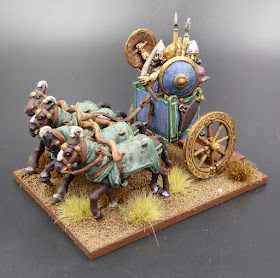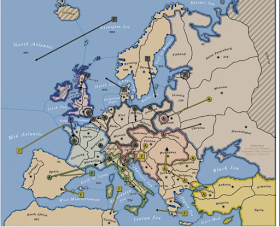 |
| French advance on Austrian positions |
Back to the replay of Montebello 1859 using Risorgimento 1859 rules. To help reduce unit naming confusion, Austrian infantry battalions are prefaced by "IR" wherein French infantry battalions have no such designation. The two previous posts in this series can be found at:
Montebello Setup
BatRep Montebello First Hour of Battle
Picking up where the battle left off, the battle has reached 3:30pm with Forey's French division's initial probes on Genestrello transforming into a hard driving offensive against Austrian advance positions. Genestrello has fallen and Urban's command is reeling from a number of battlefield reverses.
 |
| Austrian hussars screen battered infantry |
3:30pm. Stadion grabs the initiative in an attempt to stabilize his situation. Although his mission began as a recon in force, he seems to have smacked a hornet's nest and Frenchmen are swarming out of the Voghera hive and descending upon his overextended positions. Everywhere!
 |
| Schaafgottsche brings up reinforcements through Casteggio |
In front of Montebello, Urban moves to join 3/IR39 which only manages to recover from disruption and not loss of combat effectiveness. On the eastern approaches to Genestrello, Schaafgottsche attempts to rally 3/IR59 to no avail but the 3rd Jaegers rally. No offensive actions are undertaken by the Austrians across the front as the bottom of the hour is spent consolidating lines and attempting to bring order out of the chaos of the initial contacts with the enemy.
 |
| Austrians fall back from Genestrello and prepare Montebello |
 |
| Austrians regroup at Montebello |
Forey continues applying pressure on Urban's positions between Genestrello and Montebello. Beuret's brigade attacks Schaafgottsche. The 3/84th pushes back 3/IR59, 1/91st disrupts 1/3 Jaegers, and 1/84th drives 1/IR40 back towards Montebello, disrupted. Beuret drives all before him. North of Genestrello, one squadron of Montferrato light cavalry attack one squadron of the 12th Hussars who are attempting to delay Blanchard's advancing French brigade. In the clash, both squadrons take casualties and break off for the rear.
 |
| Cavalry clash north of Genestrello |
4:00pm. After pushing back much of Schaafgottsche's command, Forey maintains his momentum and presses on. Leading the 1/91st, Forey attacks the 1/3rd Jaeger disrupting it and forcing it to retreat. The 3/IR59, nearing collapse, is hit by 3/84th while Schaafgottsche attempts to rally this beleaguered battalion. The French scatter 3/IR59th and Schaafgottsche falls, mortally wounded. Seeing the destruction of its adjacent support and the death of its commander, 2/3rd Jaeger loses its nerve and begins a retrograde back to Montebello. Before it can reach safety, however, the 1/17th Chasseurs catch the unlucky jaegers and force it back a second time. The jaegers make their retrograde with a bit more urgency. Keeping pressure up, the 2/17th Chasseurs close in on 1/3rd Jaegers. Although Stadion himself intervenes, the jaegers fall back towards Montebello. As the jaegers retreat, the light infantry passes through the already wavering 1/IR40 and 3/IR59 battalions. Seeing the jaegers withdraw under pressure is too much and both battalions retreat as well.
 |
| French chasseurs begin probing Montebello defenses |
 |
| Austrian defense of Montebello |
Advancing along the main road and into short range of the Szluiner Grenz, 1/84th unleashes a short range volley before the grenz can react and the Austrian border troops fall back with moderate casualties. As the French advance continues, 1/74th and 2/98th in combination drive off a squadron of the 12th Hussars while the 3/74th charges the 3/IR40. 3/IR40 retreats before the French can close. This unforced retreat uncovers 2/IR40 and opens it up to an attack by 3/98th. Getting off a volley, 2/IR40 causes some casualties to the French and the attack devolves into a firefight as neither battalion is willing to give ground.
 |
| Birds eye view of attack on Montebello |
 |
| Concentration at Montebello from behind French lines |
Desperate from the collapse of his positions along the main road, Urban's column focuses all efforts on stabilizing his dire situation. While Urban and Stadion join wavering battalions to rally them, Austrian artillery in Montebello fires into the 1/17th Chasseurs causing casualties and slowing down its advance upon Montebello.
 |
| French prepare for assault |
4:30pm. With Urban's position collapsing quickly and no succor from either Hesse or Paumgarten's columns, Forey maintains the initiative and presses on. The 2/Novarra light cavalry swings around Montebello and attacks 3/IR39 from above as Stadion is attempting to rally it. Although wavering, Stadion's leadership allows the 39th to change facing and pour a volley into the approaching Sardinian cavalry. Suffering heavy casualties, the Sardinians press on and scatter the remnants of the battalion with Stadion seeking cover. With the destruction of the 3/IR39th, many of the battalions around Montebello become disrupted. Unable to stand up to the scattering of IR39, Baum's artillery and 3/IR40 retreat back towards the Coppa River.
 |
| Destruction of 3/IR39 |
 |
| Pressure mounts on Montebello |
Beuret's guns pound the Szluiner Grenz and it falls back to the rear. 1/17th Chasseurs attack Schaafgottsche's guns after the fail to slow the chasseurs advance upon its position in front of Montebello. Fire from the chasseurs is too hot for the gunners. The battery limbers and makes its escape although a few guns are captured. As Forey continues his advance astride the main road, fire from the 3/98th routs 2/IR40 carrying it off into the rear.
 |
| 17th Chasseurs a Pied attack the guns! |
Trying to relieve pressure from Urban's column, Hesse to the north launches an all out attack against much of Blanchard's brigade. Despite an advantage in numbers, attacks by both IR31 and IR61 end in disaster for Hesse as both attacks are repulsed with heavy casualties.
 |
| Hesse's attack repulsed |
5:00pm. While Montebello remains in Austrian hands at the 5pm hour, Stadion considers his options. Having expended his chance in the north to turn the French flank and much of Urban's column in retreat back towards the relative safety of the Coppa, Stadion abandons thoughts of maintaining a foothold on the western bank of the Coppa River. With limited passages across the river, Stadion will put in place strong defensive positions should Forey consider a pursuit. Urban abandons Montebello and will conduct a fighting withdrawal back to the river. Forey will not oblige. Unable to pursue and cross the Coppa in force, I give the French a marginal victory.
Postscript. This replay generally mirrored the historical battle quite closely although holding Montebello until 6pm by the Austrians would have been a difficult proposition. The tabletop commander, Baum, found taking Cascina Nuova too great a task; a task his historical counterpart managed briefly. Capturing Cascina Nuova would have held up the French crossing of the stream and aided Baum's reinforcement of either Genestrello or Montebello later. As it was, Baum's initial attack was bloodily repulsed and not only were the French not held up at Cascina Nuova but the battered Baum was unable to assist in the defense of Montebello.
Several factors conspired against the Austrians. First, the qualitative advantage in both troop and leader effectiveness put the French in a position of local superiority at all critical points on the battlefield. Although the Austrians outnumbered the French, poor leadership and a mission of a reconnaissance kept the Austrians from bring that numerical advantage to bear. Not only could the French give out and take more punishment but superior leadership allowed French troops much greater flexibility in either responding to local threats or taking advantage of local opportunities.
Another factor was that of reinforcement arrival. French reinforcements arrived promptly and slightly ahead of the historical schedule while their Austrian counterparts were much slower in making it to the point of decision. In fact, Paumgarten's Center Wing played no role in the battle except for covering Urban's retreat back across the Coppa.
To fight Montebello again, I must consider and weigh all of these factors. Historical accounts state that many of the Austrian troops lacked motivation and did not stand up to the French opponents in an equal fight. Was this due to troop quality or the quality of its leadership? Most of the Austrian command structure, I rated as either "Poor" or "Average" based on historical performance Perhaps a "Poor" rating was too severe?
In a refight, perhaps Baum ought to fall back on Montebello immediately rather than marching forward to engage the French at Cascina Nuova? Rather than keeping Urban and Hesse active at the expense of Paumgarten, perhaps, Stadion ought to focus on getting Paumgarten engaged more quickly at the expense of Hesse? I may try that strategy next time.
Even after such a long hiatus with the rules, I am pleased with the progression of the battle. A number of questions arose during play and several annotations have been scribbled into the game log for later consideration. While the game was played using the QRS only, the time may have come to codify more of the intricacies of the rules and get those down on paper rather than maintained in my head or as a series of game notes. I want to give Montebello another trial before the dust settles both over the rules and my mind again. Getting this collection back out onto the gaming table after a two-year lull was great fun.




























































